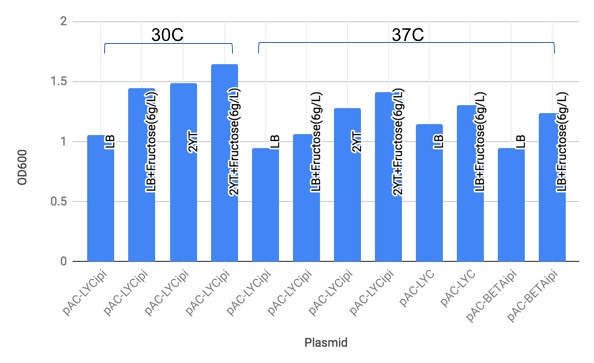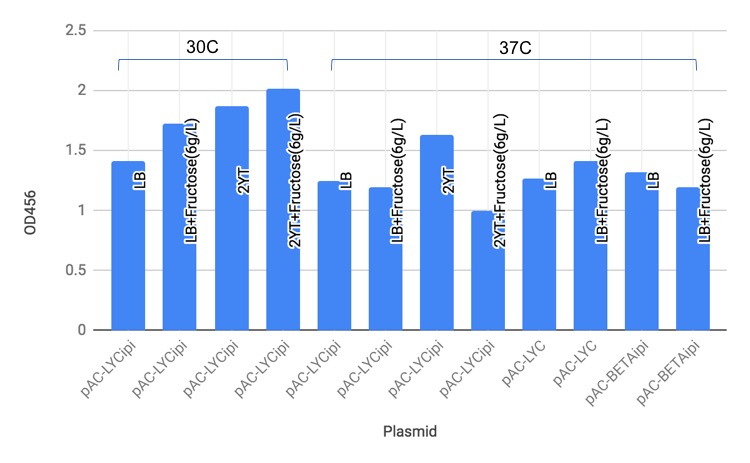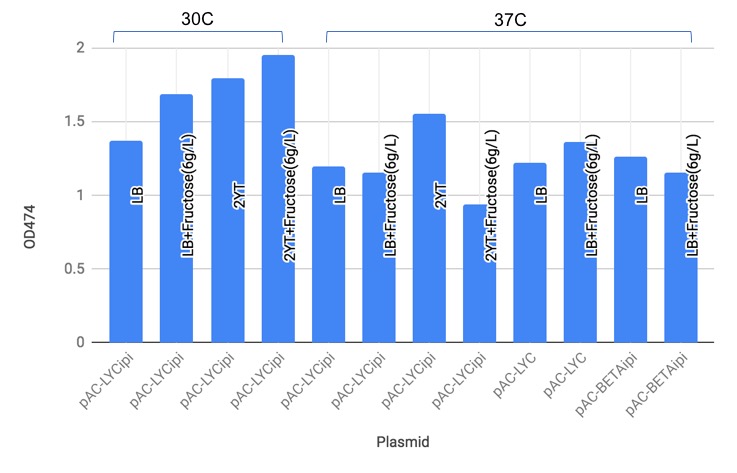Week 5: Lycopene and Beta-Carotene Production
The effects of growth substrate and pathway engineering on pigment production in E. coli
Effect of growth conditions on E. coli cell density
- The variables were as follows:
- Plasmid transformed into the cell: pAC-LYC (lycopene production pathway), pAC-LYCipi (lycopene production pathway plus idi gene to boost lycopene production), pAC-BETAipi (additional gene to go from lycopene to beta-carotene, plus idi)
- Growth substrate: LB (normal growth medium), 2YT (growth medium with twice the amount of nutrients from yeast extract tryptone), addition of fructose
- Growth temperature: 30 or 37 degrees C (the latter being the typical optimal growth temperature for E. coli)
I averaged OD600 measurements from two identical trials (a duplicate of every condition) - we took measurements twice for each trial, but the first set of measurements were inaccurate due to lack of mixing of culture before aliquoting into plate. The average standard deviation was 0.067. The data suggests that more nutrients (2YT > LB) and the addition of fructose results in faster growth regardless of growth temperature or expressed plasmid. This makes sense: more nutrients means more substrates for the cell to use in protein production. The fructose effect could either be because it's simply an additional sugar (energy) source, or potentially also because fructose is one step after glucose in the glycolysis pathway, such that one ATP molecule (energy unit) is saved for each fructose used by the cell instead of glucose. It appears that growing at 30C results in slightly greater cell density, likely because of how temperature effects the expression of the plasmid and the metabolic cost to the cell as a result of that. Cultures expressing pAC-LYC appear to have greater cell density than those expressing pAC-LYCipi, which makes sense since the former has one less protein to expend resources on. It seems possible that after fructose is added, pAC-BETAipi expressing cultures have greater cell density that pAC-LYCipi expressing cultures.

Absorption Spectrums of Extracted Pigment
After we performed acetone extraction of the pigments from the cells (acetone precipitates the cellular proteins but dissolves lycopene and beta-carotene), we used the plate reader to calculate absorption spectrums for each sample. The beta-carotene absorption peak at its maximum absorption of 456 nm was much higher than the lycopene absorption peak at its maximum absorption of 474 nm. (In the picture below, the columns are in reverse order of the culture chart in the protocol.) The hypothesis is that beta-carotene absorbs light better than lycopene.

Effect of growth conditions on pigment production
We also measured the optical density of the acetone-extracted pigment solutions, at both 456 nm and 474 nm. Here I'm using data from a classmate. I used all the measurements (duplicate measurements of duplicate trials for a total of 4 replicates) except for two clear outliers. The average standard deviation for both wavelengths was about 0.043. Note that the numbers in each graph do not directly correlate to quantity of beta-carotene or lycopene respectively; there are other pigments that are produced, for example zeaxanthin, whose absorption spectrum overlaps with that of beta-carotene and lycopene, including each other's.
As was the case with cell density, the lower temperature culture incubation resulted in higher production of pigments. Interestingly, for the cells that were both 1) transformed with plasmids containing the production-promoting idi gene (LYCipi and BETAipi) and 2) grown at the higher temperature, the addition of fructose decreases production of pigment.


Discussion Questions
- One option for increasing lycopene production from the pAC-LYC baseline is to insert the farnesyl diphosphate synthase gene (ispA) (from a different species, such as Erwinia herbicola, so that the E. coli cannot regulate its expression as tightly as it would its own FDPS gene) to increase production of farnesyl diphosphate which is metabolized to lycopene. ispA is part of the terpenoid pathway, and turns geranyl diphosphate into the FPP isomer (E,E-FPP) that is metabolized to geranyl geranyl diphosphate which is used in the carotenoid pathway. This is similar to the pAC-LYCipi strategy, which introduces an exogenous copy of the idi gene from Erwinia, which is responsible for synthesizing DMAPP, which is then metabolized to GPP. An alternative approach could be to delete an endogenous gene (probably with lambda-red recombination, since last I checked E. coli was bad at homologous recombination?) in the E. coli genome which uses up a metabolite in the terpenoid pathway (E. coli doesn't have any of the genes from the carotenoid pathway at all) to synthesize something other than lycopene. These are ispH, ispU, and ispB.
- We can see that CrtR is the enzyme characterized as metabolizing beta-carotene to zeaxanthin, as part of the carotenoid pathway.
The Dark Side of Beta-Carotene
Beta-carotene is widely acclaimed for its health benefits for its antioxidant properties and for being a precursor to Vitamin A. But how good it is for you could depend on the person; according to Sigma-Aldrich, beta-carotene “reduces the incidence of many cancers, but enhances lung cancer incidence in smokers.”